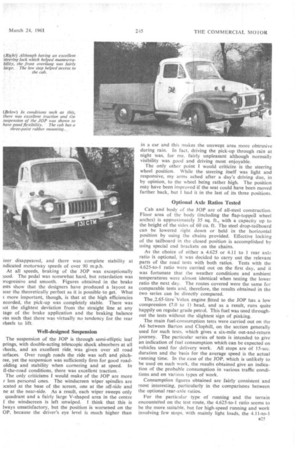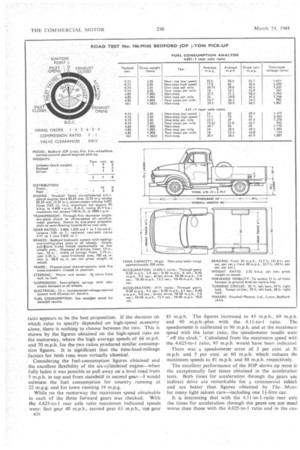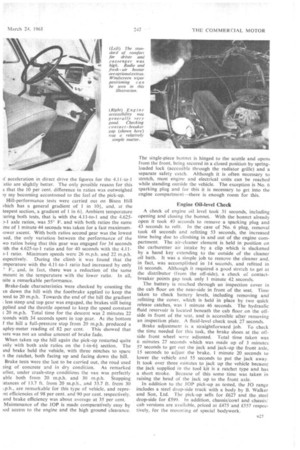WHOOSH!
Page 58

Page 59

Page 60

Page 61

If you've noticed an error in this article please click here to report it so we can fix it.
Vivid Performance of Velox-engined Bedford JOP Pick-u1
AGAINST the current tendency of some manufacturers to fit their smaller car engines into vehicles in the 12and 15-cwt. ranges, Vauxhall Motors, Ltd., match the Velox 2.65-litre engine to the +-ton payload of the Bedford JOP pick-up. It is not surprising, therefore, that the performance put up by this comparatively recent introduction was quite fantastic for a British vehicle of its type, and in most respects equalled—in some, even surpassed—that obtainable from a modern light saloon car.
After driving light vans which have kept up with London traffic only with difficulty, it was both pleasant and exhilarating to be, without even trying, amongst the leaders from traffic lights. Expressions on the faces of drivers who had been " left " were most interesting. One taxidriver, who had been rather badly dropped-.at one set of lights, said, when he caught up at the next, "Cot. mate! what you got under there?" It was also interesting to imagine the thoughts of drivers on the motorway when passed at 70 m.p.h.—still accelerating.
The surfeit of power provided by the 2.65-litre engine is obviously able to cope with up to three or four times the load the JOP is designed to carry. While it could be favourably considered as suitable and reasonably economical for use as a general purpose truck, I would say that it is more ideally suited as a combination of car and truck.
Vauxhall, in their publicity literature, suggest that the JOP is "boss transport," and this is an apt name for it. I can think of no vehicle more" suitable as the personal transport of a farmer or estate manager, or for the use of construction engineers on large sites. One hundred possible applications for the JOP are listed by Vauxhall. Included in the list are many probable overseas users for whom the JOP would be the ideal vehicle, among them oil company personnel, ranchers and mining contractors. In fact, the JOP is ideal in all circumstances where passenger car comfort and handling are required with the need to t able to cope with light loads or equipment from time t time.
In helping to satisfy the demand that there is for this tyr of vehicle, the JOP is the first British-built pick-up t approach the standard of such vehicles manufactured i the United States.
Performance is not the only respect i which the JOP is comparable to a car. Acce: to the cab could not be better and ti standard of driver amenity is also very higl The full-width bench seat provides comfor able accommodation for three adults. With two passenger the driver's actions are not hindered at all, due to th arrangement of the steering column-mounted gear chang and the location of the hand-brake lever at the right-han side of the seat. Both controls, incidentally, are we designed—gear changing on the three forward (all synchrt mesh) and reverse gearbox is direct and positive, an application of the hand-brake is helped by good leverag Lighting and other switches are conveniently placed an the robust switch for the flashing direction indicato (which are an optional extra) is mounted on the steerir column. As the units are not self-cancelling, the switc incorporates a small green warning light, but this is almo superfluous as it would be impossible not to see the wini mounted flashers operating.
Steering of the pick-up is light and accurate. The' was a tendency to over-steer on left-hand bends, but on when I was driving alone. Similarly, there was a sligl instability when alone, and approaching maximum spec on MI. However, when carryings a passenger, the ove teer disappeared, and there was complete stability at ndicated motorway speeds of over 90 m.p.h.
At all speeds, braking of the JOP was exceptionally ;ood. The pedal was somewhat hard, but retardation was trogreSsive and smooth. Figures obtained in the brake ests show that the designers have produced a layout as tear the theoretically perfect as it is possible to get. What s more important, though, is that at the high efficiencies ecorded, the pick-up was completely stable. There was lot the slightest deviation from the straight line at any tage of the brake application and the braking balance vas such that there was virtually no tendency for the rear vheels to lift.
Well-designed Suspension The suspension of the JOP is through semi-elliptic leaf prings, with double-acting telescopic shock absorbers at all vheels, and an excellent ride was given over all road urfaces. Over rough roads the ride was soft and pitchree, yet the suspension was sufficiently firm for good roadolding and stability when cornering and at speed. In if-the-road conditions, there was excellent traction.
The only criticisms I would make of the JOP are more r less personal ones. The windscreen wiper spindles are vated at the base of the screen, one at the off-side and ne at the near-side. As a result, each wiper sweeps only quadrant and a fairly large V-shaped area in the centre f the windscreen is left unwiped. I think that this is lways unsatisfactory, but the position is worsened on the OP, because the driver's eye level is much higher than
in a car and this makes the unswept area more obtrusive during rain. In fact, driving the pick-up through rain at night was, for me. fairly unpleasant although normally visibility was good and driving most enjoyable.
The only other point I would criticize is the steering wheel position. While the steering itself was light and responsive, my arms ached after a day's driving due, in by opinion, to the wheel being rather high. The position may have been improved if the seat could have been moved farther back, but I had it in the last of its three positions.
Optional Axle Ratios Tested
Cab and body of the JOP are of all-steel construction. Floor area of the body (including the flap-toppea wheel arches) is approximately 35 sq. ft., with a capacity up to the height of the sides of 60 cu. ft. The steel drop-tailboard can be lowered right down or held in the horizontal position by using the chains provided. Effective locking of the tailboard in the closed position is accomplished by using special end brackets on the chains.
As the choice of either a 4.625 or 4.11 to 1 rear axle ratio is optional, it was decided to carry out the relevant parts of the road tests with both ratios. Tests with the 4.625-to-1 ratio were carried out on the first day, and it was fortunate that the weather conditions and ambient temperatures were almost identical when testing the lower ratio the next day. The routes covered were the same for comparable tests and, therefore, the results obtained in the two series can be directly compared.
The,2.65-litre'Velox engine fitted to the JOP has a low compression (7.0 to 1) head, and as a result, runs quite happily on regular grade petrol. This fuel was used throughout the tests without the slightest sign of pinking.
The main fuel-consumption tests were carried out on the A6 between Barton and Clophill, on the section generally used for such tests, which gives a six-mile out-and-return journey. The particular series of tests is intended to give an indication of fuel consumption which can be expected on vehicles used for delivery work. All stops are of 15-sec. duration and the basis for the average speed is the actual running time. In the case of the JOP, which is unlikely to be used on such work, the results obtained give an indication of the probable consumption in various traffic conditions and on various types of Work.
Consumption figures obtained are fairly consistent and most interesting, particularly in the comparisons between the optional rear-axle ratios.
For the particular type of running and the terrain encountefed on the test route, the 4.625-to-1 ratio seems to be the more suitable, but for high-speed running and work involving few stops, with mainly light loads, the 4.11-to-1 ratio appears to be the best proposition. If the decision on which ratio to specify depended on high-speed economy alone, there is nothing to choose between the two. This is shown by the figures obtained on the high-speed runs on the motorway, where the high average speeds of 66 m.p.h. and 70 m.p.h. for the two ratios produced similar consumption figures. It is significant that the time-load-mileage factors for both runs were virtually. identical.
Considering the fuel-consumption figures obtained and the excellent flexibility of the six-cylindered engine-when fully laden it was possible to pull away on a level road from 5 m.p.h. in top and from standstill in second gear-I would estimate the fuel consumption for country running at 22 m.p.g. and for town running 19 m.p.g.
While on the motorway the maximum speed obtainable in each of the three forward gears was checked. With the 4.625-to-1 rear axle ratio maximum indicated speeds were: first gear 40 m.p.h.. second gear 63 m.p.h., top gear 13.26 85 m.p.h. The figures increased to 43 m.p.h., 69 m.p.h. and 90 m.p.h.-plus with the 4.11-to-1 ratio. The speedometer is calibrated to 90 m.p.h. and at the maximum speed with the latter ratio, the speedometer needle went off the clock." Calculated from the maximum speed with the 4.625-to-1 ratio, 95 m.p.h. would have been indicated There was a speedometer error of 3 per cent. at 3( m.p.h. and 5 per cent. at 60 m.p.h. which reduces tht maximum speeds to 81 m.p.h. and 88 m.p.h. respectively.
The excellent performance of the JOP shows up most ir the exceptionally fast times obtained in the acceleratior tests. Both times for acceleration through the gears anc indirect drive are remarkable for a commercial vehich and are better than figures obtained by The Moto for many light saloon cars-including one 11-litre car.
It is interesting that with the 4.11-to-l-ratio rear axle the times for acceleration through the gears are not mudl worse than those with the 4.625-to-1 ratio and in the casi
d acceleration in direct drive the figures for the 4.11-to-1 .atio are slightly better. The only possible reason for this
s that the 10 per cent, difference in ratios was outweighed iy my becoming accustomed to the feel of the pick-up. Hill-performance tests were carried out on Bison Hill vhich has a general gradient of 1 in 101, and, at the teepest section, a gradient of 1 in 64. Ambient temperature uring both tests, that is with the 4.11-to-1 and the 4.625-1 axle ratios, was 55' F. and with .both ratios the same me of 1 minute 44 seconds was taken for a fast maximum • ower ascent. With both ratios second gear was the lowest sed, the only variation between the performance of the wo ratios being that this gear was engaged for 34 seconds ith the 4.625-to-1 ratio and for 40 seconds with the 4.11)-1 ratio. Minimum speeds were 26 m.p.h. and 22 m.p.h. espectively. During the climb it was found that the ,mperature with the 4.11-to-1 ratio had increased by only ° F., and, in fact, there was a reduction of the same mount in the temperature with the lower ratio. In all, uite a remarkable performance.
Brake-fade characteristics were checked by coasting the an down the hill with the footbrake applied to keep the >eed to 20 m.p.h. Towards the end of the hill the gradient less steep and top gear was engaged, the brakes still being pplied and the throttle opened to keep the speed constant t 20 m.p.h. Total time for the descent was 2 minutes 22 :conds with 34 seconds spent in top gear. At the bottom f the hill a full-pressure stop from 20 m.p.h. produced a apley-meter reading of 82 per cent. This showed that 'ere was not an undue amount of brake fade.
When taken up the hill again the pick-up restarted quite Bib, with both axle ratios on the 1-in-6+ section. The and brake held the vehicle, with three nbtches to spare n the ratchet, both facing up and facing down the hill. Brake tests were the last to be carried out, the road used aing of concrete and in dry condition. As remarked 'flier, under crash-stop conditions the van was perfectly able both from 20 m.p.h. and 30 m.p.h. Stopping stances of 13.7 ft. from 20 m.p.h., and 33.7 ft, from 30 i.p.h., are remarkable for this type of vehicle, and reprent efficiencies of 98 per cent. and 90 per cent. respectively. and brake efficiency was about average at 35 per cent. Maintenance of the JOE' is made comparatively easy by )od access to the engine and the high ground clearance.
The single-piece bonnet is hinged to the scuttle and opens from the front, being secured in a closed position by springloaded lock (accessible through the radiator grille) and a separate safety catch. Although it is often necessary to stretch, most engine and electrical units can be reached while standing outside the vehicle. The exception is No. 6 sparking plug and for this it is necessary to get into the engine compartment—there is enough room for this.
Engine Oil-level Check
A check of engine oil level took 31 seconds, including opening and closing the bonnet. With the bonnet already open it took 40 seconds to remove a Sparking plug and 43 seconds to refit. In the case of No. 6 plug, removal took 48 seconds and refitting 53 seconds, the increased time being due to climbing in and out of the engine compartment. The air-cleaner element is held in position on the carburetter air intake by a clip which is slackened by a hand key extending to the outside of the cleaner oil bath. It was a simple job to remove the cleaner and, in fact, was accomplished in 14 seconds, and refitted in 16 seconds. Although it required a good stretch to get at the distributor (from the off-side). a check of contactbreaker points gap took only 1 minute 42 seconds.
The battery is reached through an inspection cover in the cab floor on the near-side in front of the seat. Time taken to check battery levels, including removing and refitting the cover, which is held in place by two quick release catches, was 1 minute 46 seconds. The hydraulic fluid reservoir is located beneath the cab floor on the offside in front of the seat, and is accessible after removing an inspection plate. A fluid-level check took 27 seconds.
Brake adjustment is a straightforward job. To check the time needed for this task, the brake shoes at the offside front wheel were adjusted. Total time taken was 6 minutes 27 seconds which was made up of 3 minutes 57 seconds to get out the jack and jack-up the front axle, 15 seconds to adjust the brake, 1 minute 20 seconds to lower the vehicle and 55 seconds to put the jack away. It took over three minutes to jack up the vehicle because the jack supplied in the tool kit is a ratchet type and has a short stroke. Because of this some time was taken in raising the head of the jack up to the front axle.
In addition to the JOP pick-up as tested, the JO range includes a steel drop-side truck with a body by B. Walker and Son, Ltd. The pick-up sells for £627 and the ,steel drop-side for £599. In addition, chassis/cowl and chassis/ cab versions are available, priced at £475 and £557 respectively, for the mounting of special bodywork.




































































































































